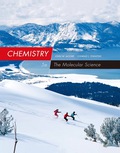
Concept explainers
Interpretation:
The maximum wavelength of the radiation that would be diffracted by
Concept Introduction:
The maximum wavelength of the radiation that would be diffracted by a crystal is equal to its unit cell edge length.
Where,
The energy of radiation is proportional to its frequency of radiation according to the equation as given below.
Where,
Frequency and energy range of electromagnetic radiation:
| Frequency Range | Energy Range | |
| Gamma rays | ||
| UV | ||
| IR | ||
| Microwaves | ||
| Radiowaves |
Answer to Problem 71QRT
The frequency of radiation of one photon and one mole photons are found out to be
Explanation of Solution
The maximum wavelength of the radiation that would be diffracted by a crystal is equal to its unit cell edge length. So
(a) Then, the frequency of radiation can be calculated as given below.
Therefore, the frequency of radiation of one photon is found out to be
The energy associated with one photon can also be calculated as follows,
(b) The frequency of radiation of one mole photons can be calculated as follows,
The energy associated with one mole photons can also be calculated as follows,
The energy and frequency range are coming under
Want to see more full solutions like this?
Chapter 9 Solutions
EBK CHEMISTRY: THE MOLECULAR SCIENCE
- Palladium has a cubic crystal structure in which the edge of the unit cell is 389 pm long. If the density of palladium is 12.02 g/cm3, how many palladium atoms are in a unit cell? In which of the cubic unit cells does palladium crystallize?arrow_forwardThe coordination number of uniformly sized spheres in a cubic closest-packing (FCC) array is 12. Give the coordination number of each atom in (a) a simple cubic lattice. (b) a body-centered cubic lattice.arrow_forwardHow many different unit cells can a crystal have if the unit cell a has all 90 angles between its crystal axes; b has all of its unit cell dimensions the same length; c has at least one 90 angle between axes; d has no perpendicular axes or equivalent unit cell dimensions?arrow_forward
 Chemistry: The Molecular ScienceChemistryISBN:9781285199047Author:John W. Moore, Conrad L. StanitskiPublisher:Cengage Learning
Chemistry: The Molecular ScienceChemistryISBN:9781285199047Author:John W. Moore, Conrad L. StanitskiPublisher:Cengage Learning Principles of Modern ChemistryChemistryISBN:9781305079113Author:David W. Oxtoby, H. Pat Gillis, Laurie J. ButlerPublisher:Cengage Learning
Principles of Modern ChemistryChemistryISBN:9781305079113Author:David W. Oxtoby, H. Pat Gillis, Laurie J. ButlerPublisher:Cengage Learning Physical ChemistryChemistryISBN:9781133958437Author:Ball, David W. (david Warren), BAER, TomasPublisher:Wadsworth Cengage Learning,
Physical ChemistryChemistryISBN:9781133958437Author:Ball, David W. (david Warren), BAER, TomasPublisher:Wadsworth Cengage Learning, Chemistry: Principles and PracticeChemistryISBN:9780534420123Author:Daniel L. Reger, Scott R. Goode, David W. Ball, Edward MercerPublisher:Cengage Learning
Chemistry: Principles and PracticeChemistryISBN:9780534420123Author:Daniel L. Reger, Scott R. Goode, David W. Ball, Edward MercerPublisher:Cengage Learning Chemistry for Engineering StudentsChemistryISBN:9781337398909Author:Lawrence S. Brown, Tom HolmePublisher:Cengage Learning
Chemistry for Engineering StudentsChemistryISBN:9781337398909Author:Lawrence S. Brown, Tom HolmePublisher:Cengage Learning General Chemistry - Standalone book (MindTap Cour...ChemistryISBN:9781305580343Author:Steven D. Gammon, Ebbing, Darrell Ebbing, Steven D., Darrell; Gammon, Darrell Ebbing; Steven D. Gammon, Darrell D.; Gammon, Ebbing; Steven D. Gammon; DarrellPublisher:Cengage Learning
General Chemistry - Standalone book (MindTap Cour...ChemistryISBN:9781305580343Author:Steven D. Gammon, Ebbing, Darrell Ebbing, Steven D., Darrell; Gammon, Darrell Ebbing; Steven D. Gammon, Darrell D.; Gammon, Ebbing; Steven D. Gammon; DarrellPublisher:Cengage Learning





